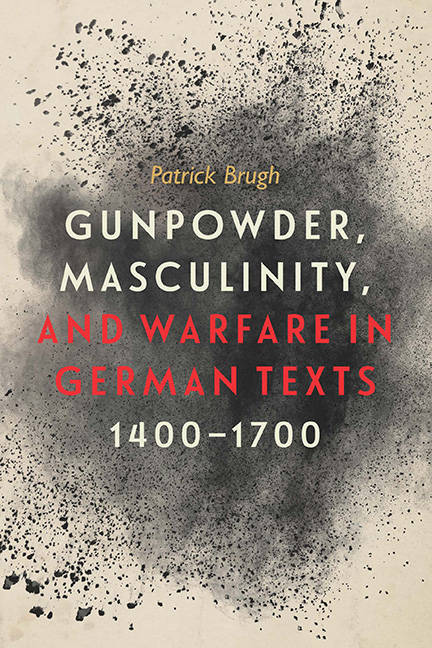Book contents
- Frontmatter
- Dedication
- Contents
- List of Illustrations
- Acknowledgments
- A Note on Translation and Spelling
- Abbreviations
- 1 A Tale of Two Suits of Armor
- 2 Of Hussites and Haystacks, of Questions and Cannons
- 3 Textbook War: The Genealogy of Kriegsbücher
- 4 Gunpowder Dilemmas and Loaded Peace in Fronsperger's Kriegsbuch
- 5 Depicting Gunpowder in German Military Broadsheets (1630–32)
- 6 Gustav Adolf's Gunpowder Demise
- 7 The Aesthetics of Gunpowder in Seventeenth-Century German War Novels
- 8 Cavalier Endings in Happel's Der insulanische Mandorell (1682)
- Appendix: Comparisons of Broadsheets from Battles of Breitenfeld, Rain am Lech, and Lützen
- Notes
- Bibliography
- Index
6 - Gustav Adolf's Gunpowder Demise
Published online by Cambridge University Press: 25 March 2020
- Frontmatter
- Dedication
- Contents
- List of Illustrations
- Acknowledgments
- A Note on Translation and Spelling
- Abbreviations
- 1 A Tale of Two Suits of Armor
- 2 Of Hussites and Haystacks, of Questions and Cannons
- 3 Textbook War: The Genealogy of Kriegsbücher
- 4 Gunpowder Dilemmas and Loaded Peace in Fronsperger's Kriegsbuch
- 5 Depicting Gunpowder in German Military Broadsheets (1630–32)
- 6 Gustav Adolf's Gunpowder Demise
- 7 The Aesthetics of Gunpowder in Seventeenth-Century German War Novels
- 8 Cavalier Endings in Happel's Der insulanische Mandorell (1682)
- Appendix: Comparisons of Broadsheets from Battles of Breitenfeld, Rain am Lech, and Lützen
- Notes
- Bibliography
- Index
Summary
A prince should assume personal command and captain his troops by himself.
—Niccolò Machiavelli, The PrinceIf Protestant partisans of the Thirty Years War were ever going to criticize gunpowder weapons or gunpowder warfare using partisan rhetoric, they would have done so after Gustav Adolf, “the Lion of the North,” was shot and killed at the Battle of Lützen in November 1632. Since landing in Usedom in July 1630, he had been campaigning from north to south in Germany for twenty-nine months. Historical accounts differ widely as to how he died and who shot him, but he is unanimously said to have been killed by gunpowder weapons, plural. As expected, an analysis of broadsheets covering the Battle of Lützen puts firearms at the forefront of their narratives, yet they attribute both negative and positive symbolic value to them. Based on the well-worn trope of the noble warrior cut down by an arbitrary gunshot, one might expect that firearms would be demonized in the wake of Adolf's dramatic death. Instead, in broadsheets from the Swedish king's campaigns in Germany at least, gunpowder weapons act as supple vehicles of political and moral metaphor just as they did in the Breitenfeld broadsheets.
The death of Gustav Adolf was politically and strategically the greatest blow that Protestant forces could have received during the Thirty Years War. After the failures of Frederick V and Christian IV, militant Protestants invested a great deal of hope in the Lion of the North. In the short years after his landing, he had transformed the Protestant military situation from a plunging abyss of dismal failures into a mounting range of well-publicized successes. With the help of native German troops, some skeptical Protestant allies, and Scottish imports, Gustav Adolf had expanded Swedish and Protestant military influence by defeating and expelling Imperial forces while taking new territory in the process. By 1632, he had in a practical and nearly political sense more power and influence in the German lands than Emperor Ferdinand II. We will briefly consider Gustav Adolf's ascent to political and military power to have proceeded in two phases: first, his rise to power as king of Sweden; and second, his entry into the German Imperial conflict, “The German War,” which later became known as the Thirty Years War.
- Type
- Chapter
- Information
- Gunpowder, Masculinity, and Warfare in German Texts, 1400–1700 , pp. 121 - 149Publisher: Boydell & BrewerPrint publication year: 2019



